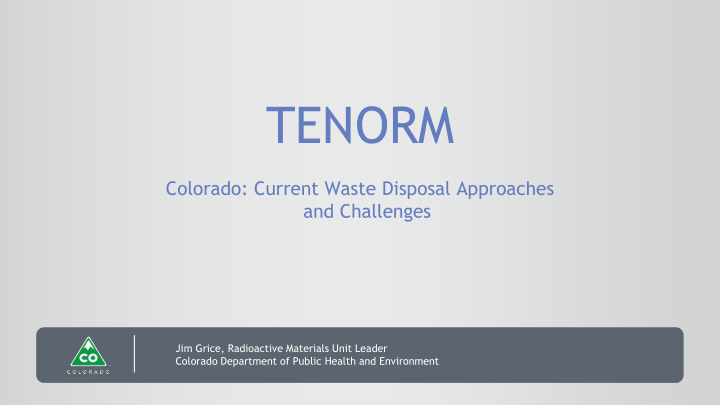



TENORM Colorado: Current Waste Disposal Approaches and Challenges Jim Grice, Radioactive Materials Unit Leader Colorado Department of Public Health and Environment
Disposal as Solid Waste Administrative Release Levels Below may be treated without regard to their radioactive constituents Combined Radium – 3 pCi/g above background Natural Uranium – 30 pCi/g above background Natural Thorium – 3 pCi/g above background Specific Radioactive Materials License Threshold Combined Radium – 50 pCi/g above background Natural Uranium – 339 pCi/g above background Natural Thorium – 55 pCi/g above background
Disposal as Solid Waste Solid Waste RCRA Subtitle D Municipal Solid Waste Industrial Restrict Dose to Public to 25 mrem annually RESRAD (worker and 1000 yr resident) CAP-88 or MILDOSE (Radon offsite estimates if methane collection system is used)
Disposal as Solid Waste EDOP Revision with CDPHE Approval Acceptance Criteria Total Volume Operations consistent with Dose Assessment Permit or Certificate of Designation Revision/Modification Local Government Approval Required per the Colorado Solid Waste Act
Challenges Concentration limits for RCRA D What wastes should be characterized? What is an appropriate or statistically defensive characterization? How long is a waste profile good for?
Concentration limits Upper bounds of 50 pCi/g in an engineered landfill Likely less than 100% of waste volume 0.05% by mass for U and Th Regulatory limit. Pb, Po, etc. Unsupported Daughters In general these can be at 50 pCi/g as well Worker dose is more problematic than resident farmer.
Waste Streams of Interest Water Treatment: O&G E&P: Drinking Water Filter socks IX Media Tank bottoms Green Sand Horizontal cuttings in uranium bearing formations HMO Filter press cake Soils from discharge area/impoundment Residual materials dislodged during cleaning and maintenance activities on the Wastewater (if there is a discharge to the following: system from another water treatment activity) Crude oil pipeline (pipe scale scraping/rattling/wire brushing) Biosolids Natural Gas scrubbers, compressors, Drying beds reflux pumps, control valves and Industrial (any treatments that would product lines likely concentrate metals) Gas/oil separators Any Filter media Dehydration vessels Soils from discharge Liquid natural gas (LNG) storage tanks area/impoundment
How to characterize? How many samples is enough? Must have an adequate confidence that materials do not exceed limits EPA SW-846 Sampling plans and statistical methods for establishing confidence Generators and Disposal Facilities need to be informed
Waste Profile Validity How long can a waste profile be used? Periodic sampling and use of statistical tests to verify that the dataset is still valid for ongoing waste streams Should be spelled out in Waste Characterization Plan
Solid Waste Landfill Disposal What it can and should be: Safe, Protective, Cost effective, Sensible solution The Devil is in the details: Waste Identification, Dose assessments, Concentration limits, Waste characterization and acceptance
Thank You! Questions? Jim Grice, Radioactive Materials Unit Leader Colorado Department of Public Health and Environment james.grice@state.co.us – 303-692-3371
Recommend
More recommend